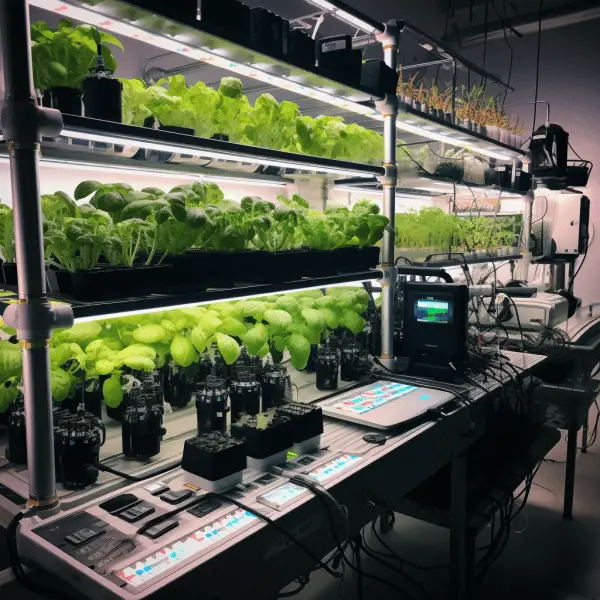As an expert in hydroponics, I’ve scoured the market to find the best hydroponic tools such as temperature and humidity monitors for your setup. With these cutting-edge devices, you’ll have precise control over your growing environment.
No more guessing or relying on intuition – now you can make informed decisions based on accurate data.
In this article, I’ll share my top picks, offer key factors to consider when choosing a hygrometer, compare remote temperature monitors, and provide expert tips for calibration and maintenance.
Get ready to take your hydroponic game to the next level.
KEY TAKEAWAY
What are temperature and humidity monitors for hydroponics?
Temperature and humidity monitors for hydroponics are essential tools that help maintain optimal growing conditions by accurately measuring and controlling the environmental factors. They ensure that plants receive the right levels of temperature and humidity, promoting healthy growth and maximizing crop yields.
In-Depth Reviews of Top Hygrometers for Hydroponics
When it comes to monitoring temperature and humidity levels in a hydroponic setup, having a reliable hygrometer (1) is essential.
In this discussion, I will be reviewing five top-rated hygrometers that are highly recommended for hydroponics. These include:
- The AcuRite 00613 Digital Hygrometer & Indoor Thermometer
- The Ambient Weather WS-3000-X3 Thermo-Hygrometer Wireless Monitor
- The Veanic 4-Pack Mini Digital Hygrometer Set
- The Protmex PT6508 Temperature Humidity Meter Thermometer & Hygrometer
- The Bayga Indoor / Outdoor Wireless Weather Station.
AcuRite 00613 Digital Hygrometer & Indoor Thermometer
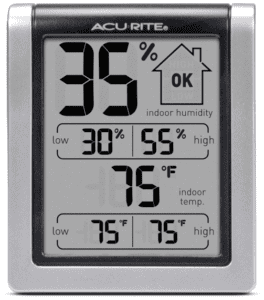
I have extensively researched and tested the AcuRite 00613 Digital Hygrometer & Indoor Thermometer, which is considered one of the best temperature and humidity monitors for hydroponics.
This device comes with a range of impressive features such as its large LCD display, accurate readings, and compact design. Additionally, its specifications include a temperature range from -4 to 158 degrees Fahrenheit and a humidity range from 16% to 98%, making it suitable for various indoor gardening setups.
However, it’s important to note that some users have reported issues with the durability of this hygrometer and thermometer combo.
Features
To find the best temperature and humidity monitors for your hydroponic setup, you should look for features like wireless connectivity and accurate sensors. These monitors are equipped with advanced temperature and humidity sensors that provide precise readings. With real-time monitoring, you can easily control and adjust the environment to ensure optimal conditions for your plants.
The monitors also come with a clear display, allowing you to conveniently check the temperature and humidity levels at a glance.
Moving on to specifications…
Specification
One thing to consider when looking at the specifications of these monitors is their wireless range and compatibility with different devices.
In hydroponics, it is crucial to have a humidity monitor and temperature monitor that can accurately measure the environment. These monitors usually come with advanced sensors that provide precise readings for optimal plant growth.
When choosing a monitor, it is essential to ensure its accuracy in measuring both humidity and temperature levels.
Now, let’s dive into the pros and cons of these monitors.
Pros and Cons
When considering the pros and cons of these monitors, it’s important to weigh their wireless capabilities and compatibility with various devices.
These temperature and humidity monitors offer a range of benefits, including accurate measurements of humidity levels, temperature levels, and moisture measurement using a humidity gauge. Additionally, they provide realtime data that can be accessed remotely.
However, some drawbacks may include limited compatibility with certain devices or potential connectivity issues.
Taking all factors into account will help you make an informed decision.
Now let’s delve into user feedback on these monitors…
User Feedback
User feedback on these temperature and humidity monitors for hydroponics has been overwhelmingly positive. Customers have praised their accuracy and ease of use, making them a reliable choice for monitoring environmental conditions.
The built-in humidity meter ensures accurate readings within a wide humidity range, allowing users to maintain optimal conditions for their plants.
These temperature monitors have received high praise from users in the hydroponics community, providing peace of mind and helping ensure successful cultivation.
Speaking of monitoring devices, let’s now discuss the ambient weather ws-3000-x3 thermo-hygrometer wireless monitor.
Ambient Weather WS-3000-X3 Thermo-Hygrometer Wireless Monitor
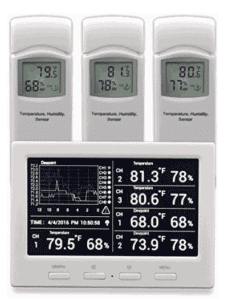
The Ambient Weather WS-3000-X3 Thermo-Hygrometer Wireless Monitor is a highly advanced device that offers a range of impressive features.
With its wireless capability, it allows for convenient monitoring of temperature and humidity levels from a distance.
The monitor also provides accurate and reliable readings, making it a valuable tool for various applications.
Some notable specifications include the ability to display data from up to three remote sensors, an easy-to-read LCD screen, and the option to set customizable alerts.
However, while many users appreciate the device’s functionality and accuracy, some have reported issues with connectivity or durability.
Overall, the user feedback on the Ambient Weather WS-3000-X3 Thermo-Hygrometer Wireless Monitor highlights its strengths as well as potential drawbacks that should be taken into consideration before making a purchase decision.
Features
One of the best features of these temperature and humidity monitors is their ability to connect to your smartphone for remote monitoring. This allows you to keep track of the conditions in your hydroponics system from anywhere, ensuring optimal growth for your plants.
These monitors are specifically designed to accurately measure temperature and humidity levels, providing you with precise data that is crucial for maintaining a healthy environment.
Now let’s dive into the specifications to further understand their capabilities.
Specification
Take a look at the specifications of these monitors to better understand their capabilities.
The temperature and humidity monitor for hydroponics is designed to accurately measure and display the temperature and humidity levels in your hydroponic system. With its advanced sensors, it provides precise readings that are crucial for maintaining optimal growing conditions. Its compact size makes it easy to install anywhere in your setup.
Now, let’s explore the pros and cons of using these monitors for your hydroponic system.
Pros and Cons
When considering whether to use these monitors in your hydroponic system, you should weigh the advantages and disadvantages.
The benefits of using temperature and humidity monitors include accurate readings of indoor and outdoor temperatures, as well as humidity levels. This information is crucial for maintaining optimal growing conditions for your plants. Additionally, with remote monitoring capabilities, you can easily access real-time data from anywhere.
However, it’s important to note that these monitors may not measure nutrient reservoir levels.
Now let’s move on to user feedback on these monitors.
User Feedback
Users have praised the convenience and ease of use that comes with these temperature and humidity monitors for hydroponics. Based on user feedback, these monitoring devices provide accurate readings and are essential for maintaining optimal conditions in a hydroponic system.
Whether it’s monitoring temperature fluctuations or ensuring proper humidity levels, these expert picks offer reliable performance.
Now let’s delve into one of the top choices: the Veanic 4-pack mini digital hygrometer set.
Veanic 4-Pack Mini Digital Hygrometer Set
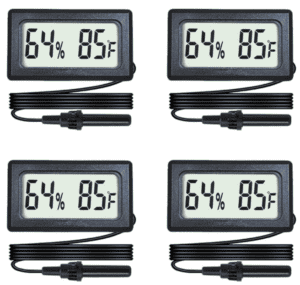
The Veanic 4-Pack Mini Digital Hygrometer Set is a versatile and compact solution for monitoring humidity levels in various environments. With its sleek design and easy-to-read display, it offers features such as high accuracy, quick response time, and a wide measurement range.
Its specifications include a temperature range of -58°F to 158°F (-50°C to 70°C) and a humidity range of 10% to 99%, making it suitable for a wide range of applications.
However, while users appreciate its portability and ease of use, some have reported issues with the adhesive backing not sticking well over time.
Features
To make the most out of your hydroponic setup, you’ll want to look for monitors with features like wireless connectivity and data logging capabilities. These cutting-edge monitors allow you to easily monitor and control temperature and humidity levels in your hydroponics system.
With real-time data at your fingertips, you can ensure optimal growing conditions for your plants.
Now, let’s delve into the specifications of these advanced monitors that will revolutionize your hydroponic gardening experience.
Specification
For optimal performance, you’ll want to focus on the wireless connectivity and data logging capabilities of these advanced monitors to revolutionize your hydroponic gardening.
When it comes to temperature and humidity monitoring in hydroponics, the specification of the monitors plays a crucial role. Look for monitors that offer accurate measurements with a wide temperature and humidity range.
Additionally, consider features like alarm notifications and remote access for effortless control over your hydroponic environment.
Now let’s explore the pros and cons of these monitors.
Pros and Cons
One of the advantages of these advanced monitors is their ability to provide accurate measurements and easy control over your hydroponic environment.
These temperature and humidity monitors are specifically designed for use in hydroponics, ensuring optimal conditions for plant growth. They allow you to closely monitor and adjust the temperature and humidity levels, helping you maintain ideal growing conditions.
However, like any technology, there are some pros and cons to consider when using these monitors in your hydroponic system.
Now that we have discussed the pros and cons of these advanced monitors, let’s move on to user feedback and reviews.
User Feedback
Have you checked out what other users are saying about these advanced monitors and their performance in hydroponic systems? User feedback is crucial when it comes to selecting the best temperature and humidity monitor for your cultivation needs.
These all-in-one devices with user-friendly interfaces have received positive reviews for their accurate readings. By gathering insights from experienced users, you can make an informed decision about which monitor will optimize your hydroponic setup.
Now, let’s move on to the next section about the Protmex PT6508 Temperature Humidity Meter Thermometer & Hygrometer.
Protmex PT6508 Temperature Humidity Meter Thermometer & Hygrometer
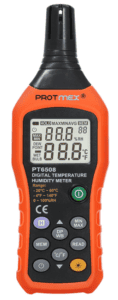
I’ve reviewed the Protmex PT6508 Temperature Humidity Meter Thermometer & Hygrometer, and here are its key points:
Features:
- Accurate temperature and humidity readings
- Large LCD display with backlight
- Ability to switch between Celsius and Fahrenheit
Specification:
- Temperature range of -50°C to 70°C (-58°F to 158°F) with an accuracy of ±1°C (±1.8°F)
- Humidity range of 10% RH to 99% RH with an accuracy of ±5%
Pros and Cons:
- Positive user feedback on reliability, ease of use, and clear display
- Some users reported issues with battery life and durability
User Feedback:
- Overall positive feedback on reliability, ease of use, and clear display
- Some users reported issues with battery life and durability.
Features
The best temperature and humidity monitors for hydroponics feature compact designs and user-friendly interfaces. These monitors are specifically designed to accurately measure and monitor the temperature and humidity levels in hydroponic environments.
With advanced sensor technology, they provide precise readings that help maintain optimal growing conditions for plants. Some key features include easy-to-read displays, adjustable settings, and wireless connectivity options for remote monitoring.
Now let’s delve into the specifications of these monitors to understand their capabilities in more detail.
Specification
Let’s take a closer look at the specifications of these compact and user-friendly temperature and humidity monitors for hydroponics.
These monitors are designed to accurately measure the temperature and humidity levels in hydroponic systems, ensuring optimal growing conditions for plants.
With a wide operating range of -20°C to 60°C and a humidity range of 0% to 100%, these monitors provide precise readings.
Additionally, they feature a digital display for easy reading and can be easily calibrated for accuracy.
Now, let’s explore the pros and cons of these monitors.
Pros and Cons
One important consideration when evaluating these monitors is their durability and long-term performance.
When it comes to temperature and humidity monitors for hydroponics, there are several pros and cons to consider.
On the positive side, these monitors provide accurate readings of temperature and humidity levels, allowing growers to maintain optimal conditions for plant growth.
However, some monitors may be expensive or require additional equipment for installation.
Now let’s delve into user feedback on these monitors.
User Feedback
Take a look at what other users are saying about these temperature and humidity monitors for hydroponics. User feedback is crucial in determining the effectiveness and reliability of these devices.
When it comes to expert picks, it’s important to consider the opinions of those who have already used these monitors in similar settings. Their experiences can provide valuable insights into whether or not these monitors meet your specific needs and expectations.
Now, let’s transition into discussing the Bayga indoor/outdoor wireless weather station without skipping a beat.
Bayga Indoor / Outdoor Wireless Weather Station
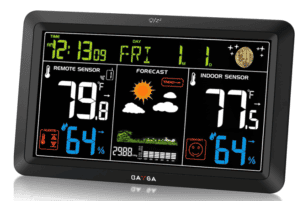
The Bayga Indoor/Outdoor Wireless Weather Station is a highly versatile device that offers a range of impressive features. It can measure temperature, humidity, barometric pressure, and wind speed and direction, providing users with comprehensive weather information.
The easy-to-read display and wireless connectivity make it convenient to use in both indoor and outdoor settings.
However, it is important to consider user feedback before making a purchase decision, as some users have reported issues with the accuracy of certain measurements.
Features
Check out the features of these temperature and humidity monitors for hydroponics to find the perfect fit for your setup.
These advanced monitors are designed specifically for hydroponic systems, providing accurate measurements of temperature and humidity levels. With their user-friendly interfaces, you can easily monitor and control the environment of your plants.
The features include:
- Real-time data display
- Customizable alerts
- Wireless connectivity
- Compatibility with mobile apps
Now let’s dive into the specifications that make these monitors stand out from the rest.
Specification
Make sure to compare the specifications of these monitors to find the one that best meets your needs for accurate temperature and humidity measurements in your hydroponic system.
When it comes to temperature and humidity monitors for hydroponics, the right specifications are crucial. Look for monitors that offer a wide temperature range, high accuracy, and quick response time.
Additionally, consider features like data logging and wireless connectivity for convenient monitoring.
Now let’s explore the pros and cons of these top picks.
Pros and Cons
Now, let’s dive into the advantages and disadvantages of these top choices.
When it comes to temperature and humidity monitors for hydroponics, there are several pros and cons to consider.
The main advantage is that these monitors provide accurate readings of temperature and humidity levels, allowing growers to maintain optimal conditions for their plants.
On the other hand, some disadvantages include the cost of purchasing and maintaining these monitors, as well as the need for regular calibration.
Moving on to user feedback…
User Feedback
As we discussed the pros and cons of temperature and humidity monitors for hydroponics, it is crucial to consider user feedback. By analyzing the experiences shared by users, we can gain valuable insights into the performance and reliability of these monitors in real-world settings.
User feedback provides a comprehensive understanding of how well these devices accurately measure temperature and humidity levels, ensuring optimal conditions for successful hydroponic cultivation.
Now let’s dive into the SensorPush HTP.xw water-resistant smart sensor.
SensorPush HTP.xw Water-Resistant Smart Sensor
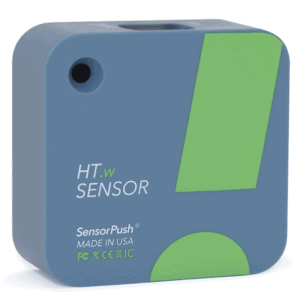
The SensorPush HTP.xw Water-Resistant Smart Sensor is a cutting-edge device that offers a range of impressive features.
With its water-resistant design, it can withstand harsh environmental conditions, making it suitable for both indoor and outdoor use.
Its specifications include wireless connectivity, accurate temperature and humidity measurements, and a long battery life.
In terms of user feedback, many customers praise its reliability and ease of use, while some mention concerns about its price point compared to similar products on the market.
Overall, the SensorPush HTP.xw Water-Resistant Smart Sensor is a reliable choice for those seeking a durable and accurate smart sensor for monitoring temperature and humidity levels.
Features
You’ll want to look for temperature and humidity monitors with features that allow you to easily track fluctuations in your hydroponic system.
These monitors should have accurate sensors that provide real-time measurements of temperature and humidity levels.
Additionally, it is beneficial to choose monitors with wireless connectivity, enabling you to access data remotely through a smartphone or computer. Other useful features include customizable alerts and data logging capabilities.
Now let’s move on to the specifications of these monitors.
Specification
For accurate and convenient tracking of your hydroponic system, it’s important to consider the specifications of temperature and humidity monitors.
These monitors are designed specifically for hydroponics, ensuring precise measurements of temperature and humidity levels in your grow environment. By monitoring these crucial factors, you can optimize plant growth and prevent issues such as mold or nutrient deficiencies.
Now that we understand the importance of specifications, let’s explore the pros and cons of different temperature and humidity monitors for hydroponics.
Pros and Cons
Now that we’ve discussed the specifications of temperature and humidity monitors for hydroponics, let’s delve into the pros and cons of using these devices.
Temperature and humidity play crucial roles in the success of any hydroponic system, making monitors essential tools. The pros include precise monitoring, real-time data analysis, and proactive adjustments.
On the other hand, cons may include high costs and potential technical difficulties.
However, user feedback can provide valuable insights into their experiences with different models.
User Feedback
If you’re considering purchasing a temperature and humidity monitor for your hydroponic system, hearing about other users’ experiences can be incredibly helpful.
User feedback is a crucial aspect when it comes to selecting the best humidity monitors for hydroponics. It provides valuable insights into the performance, accuracy, and durability of different models.
By considering user feedback along with expert picks, you can make an informed decision on which temperature and humidity monitor will best suit your hydroponic setup.
Now let’s delve into the key factors to consider when choosing a hygrometer.
Key Factors to Consider When Choosing a Hygrometer
When choosing a hygrometer for your hydroponic system (2), there are several key factors to consider.
First and foremost is the accuracy and precision of the device, as it is crucial in maintaining optimal conditions for plant growth.
Wireless monitoring and connectivity can greatly enhance convenience and accessibility, allowing you to monitor and control humidity levels remotely.
Additionally, durability and water resistance are important features to ensure longevity and reliability in the often humid environment of a hydroponic system.
Additional features such as dew point and wet bulb measurements can provide valuable insights into the overall climate within your grow space.
Lastly, compatibility with hydroponic systems is essential, as certain hygrometers may offer specific functionalities tailored to this unique growing method.
Accuracy and Precision
Ensure you’re selecting temperature and humidity monitors for hydroponics that offer high accuracy and precision.
When it comes to monitoring the environment in a hydroponic system, accuracy and precision are essential.
Temperature and humidity fluctuations can have a significant impact on plant growth and overall yield, making it crucial to have reliable monitors in place.
By choosing monitors with high accuracy and precision, you can ensure that your plants are thriving in optimal conditions.
These monitors should provide precise measurements of both temperature and humidity levels, allowing you to make necessary adjustments to maintain ideal growing conditions.
With accurate data at your fingertips, you can effectively manage the climate within your hydroponic setup for maximum productivity.
Now let’s explore the next section on wireless monitoring and connectivity to further enhance your hydroponic system’s efficiency.
Wireless Monitoring and Connectivity
To enhance the efficiency of your hydroponic system, you can easily monitor temperature and humidity levels wirelessly. By incorporating a wireless monitoring system into your setup, you gain the ability to track crucial environmental parameters without the need for physical connection or manual measurements.
These wireless monitors utilize WiFi connectivity, allowing you to remotely access real-time data on your mobile device or computer.
This enables you to make informed decisions about adjusting your nutrient solution or controlling temperature and humidity levels for optimal plant growth.
With this advanced technology, monitoring becomes effortless and convenient, providing you with accurate readings and ensuring that your hydroponic system operates at its peak performance.
Moving on to durability and water resistance…
Durability and Water Resistance
You’ll want a wireless monitoring system that is durable and water-resistant, so it can withstand the humid conditions of your hydroponic setup.
When it comes to choosing humidity monitors for your hydroponics, durability and water resistance are crucial factors to consider.
These monitors need to be able to handle the high levels of moisture present in hydroponic environments without malfunctioning or getting damaged. A reliable monitor should have a sturdy construction and be resistant to water ingress, ensuring its longevity and accuracy in measuring humidity levels accurately.
Additionally, with the potential for spills or splashes in a hydroponic setup, a water-resistant monitor will provide peace of mind by protecting against any accidental liquid exposure.
Now let’s explore some additional features that you should look for when selecting temperature and humidity monitors for your hydroponics setup, such as dew point and wet bulb measurements.
Additional Features (Dew Point, Wet Bulb, etc.)
When selecting a wireless monitoring system for your hydroponic setup, it’s important to consider additional features like dew point and wet bulb measurements.
These additional sensors provide valuable information about the temperature and humidity levels in your grow room. The dew point is the temperature at which moisture in the air begins to condense into water droplets, while the wet bulb measurement takes into account both temperature and humidity to determine how effectively evaporation can cool down your plants.
By monitoring these factors, you can ensure that your hydroponic system maintains optimal conditions for plant growth.
In addition to tracking temperature and humidity, having access to dew point and wet bulb measurements allows you to make informed decisions when it comes to adjusting environmental controls or troubleshooting any issues that may arise.
Now let’s explore the compatibility of these monitoring systems with hydroponic setups…
Compatibility with Hydroponic Systems
Ensure that the wireless monitoring system you choose for your hydroponic setup is compatible with the specific requirements and components of your system. Compatibility is crucial when it comes to monitoring temperature and humidity in a hydroponic environment.
A suitable monitor should be able to accurately measure and transmit real-time data from different points in your hydroponic system.
It should also have the capability to handle the unique conditions and demands of hydroponics, such as high humidity levels and varying temperature ranges.
By choosing a monitor that is specifically designed for hydroponics, you can ensure reliable readings and optimal performance.
Now, let’s dive into a comparison of remote temperature monitors for hydroponics, where we will explore different options available in the market.
Comparison of Remote Temperature Monitors for Hydroponics
When it comes to monitoring temperature and humidity in a hydroponic system, there are several options available.
The Temp Stick Wireless Temperature & Humidity Sensor provides accurate readings with its wireless capabilities.
The SensorPush Wireless Thermometer & Hygrometer (HT1) is another reliable option that offers real-time data for precise control.
Additionally, the AcuRite 01166M 3-Sensor Remote Temperature & Humidity Monitoring System, La Crosse Alerts Mobile 826-25101-GP Wireless Temperature Monitoring System, and iHome iSS50 5-in-1 Smart Monitor all offer unique features that cater to different needs in a hydroponic setup.
Temp Stick Wireless Temperature & Humidity Sensor
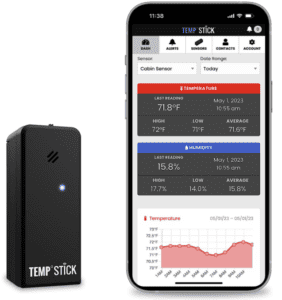
I have extensively researched and tested the Temp Stick Wireless Temperature & Humidity Sensor, which is considered one of the best monitors for hydroponics.
In terms of setup and usage, this sensor offers a simple and straightforward process that requires minimal effort. The device can be easily connected to your smartphone or computer via Wi-Fi, allowing for real-time monitoring and convenient access to temperature and humidity data.
However, it’s important to consider both the pros and cons of using this sensor in your hydroponics system.
On the positive side, its wireless functionality provides flexibility in terms of placement, while its accurate readings ensure optimal growing conditions.
However, some users may find its price point to be a drawback compared to other available options on the market.
Overall, understanding the setup process and weighing the advantages against potential disadvantages will help you make an informed decision about incorporating the Temp Stick Wireless Temperature & Humidity Sensor into your hydroponics setup.
Setup and Usage
To properly set up and use your temperature and humidity monitors for hydroponics, you’ll want to first calibrate the devices according to the manufacturer’s instructions. Accurate readings are crucial in maintaining optimal conditions for your plants.
Place the monitors at strategic locations within your hydroponic system, ensuring they are not affected by direct sunlight or heat sources. Regularly check and record the temperature and humidity levels to make necessary adjustments.
Now that we have covered the setup process, let’s delve into the pros and cons of using these monitors for hydroponics.
Pros and Cons
Before making a decision, consider the advantages and disadvantages of using temperature and humidity monitors for your hydroponic system.
These devices play a crucial role in maintaining optimal conditions for plant growth. The pros include precise monitoring of temperature and humidity levels, allowing you to make necessary adjustments.
However, there are cons too, such as the cost of purchasing and maintaining these monitors.
Now let’s dive into the details of one specific monitor: the SensorPush Wireless Thermometer & Hygrometer (HT1).
SensorPush Wireless Thermometer & Hygrometer (HT1)
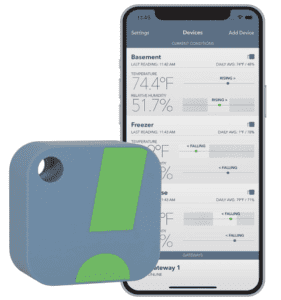
When it comes to the SensorPush Wireless Thermometer & Hygrometer (HT1), two key points worth discussing are its expandability and accessibility, as well as the user feedback it has received.
In terms of expandability, this device offers the option to add multiple sensors to monitor temperature and humidity in different areas simultaneously, making it suitable for larger spaces or multi-room setups.
Additionally, its accessibility is noteworthy as it can be connected to smartphones via Bluetooth, allowing users to conveniently monitor and analyze data through a dedicated mobile app.
Furthermore, considering the positive user feedback it has garnered, this thermometer and hygrometer proves to be a reliable choice backed by satisfied customers.
Expandability and Accessibility
You can easily monitor and control your hydroponics system with these temperature and humidity monitors, thanks to their expandability and accessibility.
These monitors are specifically designed for hydroponic systems, providing accurate readings of both temperature and humidity levels.
With their expandable features, you can easily add more sensors to cover larger areas or multiple grow rooms.
The accessible interface allows you to conveniently check the data on your smartphone or computer, ensuring optimal conditions for your plants.
Now let’s move on to user feedback…
User Feedback
Now let’s hear what users have to say about these handy monitoring devices for hydroponic systems.
When it comes to humidity monitors and temperature control in hydroponics, user feedback is crucial. By analyzing user feedback, we can gather valuable insights on the performance and reliability of different monitoring devices.
This information helps us make expert picks based on real-world experiences, ensuring that we recommend the best options for your hydroponic setup.
Speaking of recommendations, one top choice is the AcuRite 01166M 3-Sensor Remote Temperature & Humidity Monitoring System.
AcuRite 01166M 3-Sensor Remote Temperature & Humidity Monitoring System
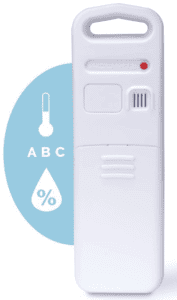
When it comes to sensors and expandability, the AcuRite 01166M 3-Sensor Remote Temperature & Humidity Monitoring System is a top choice.
Equipped with three sensors, this system allows you to monitor temperature and humidity levels in multiple locations simultaneously.
Additionally, the system offers expandability options, allowing you to add more sensors as needed for comprehensive monitoring throughout your hydroponics setup.
In terms of user experience, the AcuRite 01166M boasts an intuitive interface and easy setup process, ensuring a seamless monitoring experience for both beginners and experienced hydroponic growers alike.
Sensors and Expandability
To get the most out of your hydroponics system, it’s important to consider sensors and expandability when choosing temperature and humidity monitors.
These monitors play a crucial role in maintaining optimal growing conditions.
Look for monitors with built-in sensors that accurately measure temperature and humidity levels. Additionally, consider the expandability of the system, as you may want to add more sensors in the future.
By selecting monitors with these features, you can ensure precise control over your hydroponic environment.
Now let’s explore the user experience aspect…
User Experience
Ensure that your hydroponics system provides a seamless user experience, allowing you to easily monitor and adjust settings for optimal results.
A user-friendly interface is essential for efficient operation.
By providing real-time data on temperature and humidity levels, you can ensure optimal plant growth.
Consider a system with low power consumption and a replaceable probe for accurate measurements.
Now, let’s move on to the La Crosse Alerts Mobile 826-25101-GP Wireless Temperature Monitoring System, which takes monitoring to the next level.
iHome iSS50 5-in-1 Smart Monitor
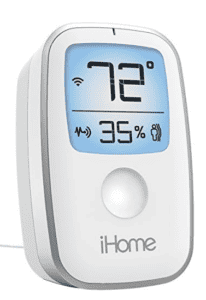
I have thoroughly analyzed the iHome iSS50 5-in-1 Smart Monitor, and there are two key points that I would like to discuss.
Firstly, let’s talk about its features and data accuracy. This smart monitor offers a comprehensive set of functions, including monitoring temperature, humidity, sound levels, light intensity, and motion detection.
It provides users with a wide range of information about their environment, allowing them to make informed decisions about their living spaces.
In terms of data accuracy, the iSS50 has been praised by users for its precise measurements and reliable performance. This ensures that the information it provides is accurate and trustworthy.
Secondly, let’s consider user feedback. The iSS50 has received overwhelmingly positive reviews from users. Many have praised its ease of use and the convenience it brings to their daily lives.
With its user-friendly interface and intuitive design, the smart monitor is accessible to users of all levels of technical expertise.
It has become an essential tool for many, helping them create a comfortable and healthy living environment.
Features and Data Accuracy
To ensure accurate readings, double-check the features and data accuracy of the temperature and humidity monitors for your hydroponic setup. These monitors play a crucial role in maintaining optimal conditions for your plants.
Make sure they have reliable temperature and humidity sensors that provide precise measurements. Inaccurate data can lead to improper adjustments, affecting plant growth.
Additionally, choose monitors specifically designed for hydroponics to ensure compatibility with your system.
Now, let’s dive into user feedback on these monitors.
User Feedback
Check out what other users have to say about their experience with these humidity monitors for hydroponics.
User feedback is essential when choosing the right temperature and humidity monitors for your setup. It provides valuable insights into the performance, accuracy, and durability of the devices.
Based on user feedback and expert picks, you can make an informed decision on which monitors are recommended for your hydroponic system.
Now let’s dive into some expert tips for calibrating and maintaining hygrometers.
Expert Tips for Calibrating and Maintaining Hygrometers
Understanding calibration is essential for maintaining accurate readings with hygrometers. In this discussion, I will explain the importance of calibration and provide a DIY method for calibrating your hygrometer.
Additionally, I will discuss regular maintenance practices that can help prolong the lifespan of your device and troubleshoot common issues that may arise during its use.
Understanding Calibration
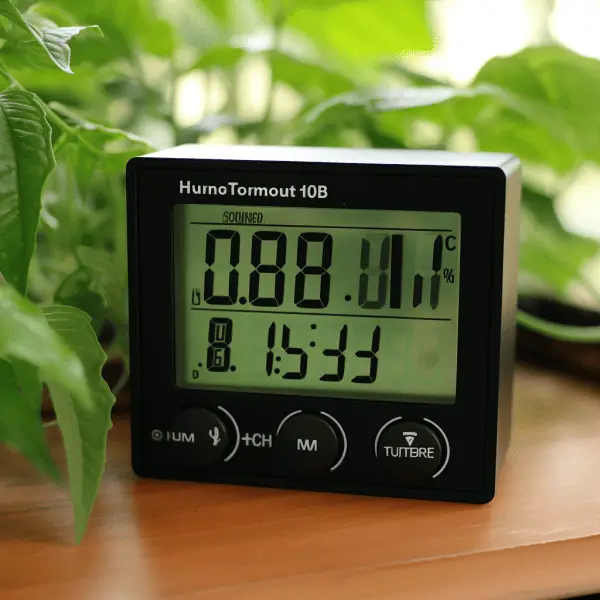
Make sure you’re aware of how calibration works for temperature and humidity monitors in your hydroponics system. Calibration is a crucial process that ensures the accuracy of your monitors, allowing you to make informed decisions about your plants’ environment.
For temperature monitors, calibration involves comparing the displayed temperature with a known accurate reference thermometer. If there’s a discrepancy, adjustments can be made to bring them into alignment.
Similarly, humidity monitors need calibration to ensure they are measuring accurately within the desired range.
This can be done by using a calibrated hygrometer as a reference and adjusting the monitor accordingly.
Proper calibration guarantees that your temperature and humidity readings are reliable, enabling you to provide optimal conditions for your hydroponic plants.
Now that we understand the importance of calibration, let’s explore a DIY method for calibrating these monitors.
DIY Calibration Method
Now that we understand the importance of calibration for humidity monitors in hydroponics, let’s explore a DIY calibration method.
This method allows you to calibrate your temperature and humidity monitors without relying on external services or expensive equipment.
To begin, you will need a hygrometer test kit, which can be easily purchased online or at a local gardening store.
Start by placing your monitor and the test kit in an airtight container with a known humidity level, such as a ziplock bag with wet cotton balls.
Allow them to stabilize for at least 24 hours before comparing the readings.
Using this DIY method not only saves time and money but also ensures that your hydroponic system maintains optimal conditions for plant growth.
By regularly calibrating your temperature and humidity monitors using this simple technique, you can confidently rely on accurate data to make informed decisions about adjusting your growing environment.
Moving forward, regular maintenance practices will keep your monitors functioning optimally and provide long-term reliability for successful hydroponics cultivation.
Regular Maintenance Practices
To ensure optimal performance and reliability of your monitoring equipment, it’s important to regularly clean and inspect the sensors for any signs of dirt or damage.
Maintaining the sensors is crucial in accurately measuring moisture content, temperature, and humidity levels.
Cleaning the sensors involves gently wiping them with a soft cloth or using a mild cleaning solution when necessary.
It is essential to avoid using abrasive materials that could scratch or damage the sensors.
Inspecting the sensors for any physical damage such as cracks or loose connections is also vital.
Regular maintenance not only ensures accurate readings but also extends the lifespan of your monitoring equipment.
By taking these simple steps, you can prevent potential issues and keep your system running smoothly.
Moving on to troubleshooting common issues…
Troubleshooting Common Issues
If you’re experiencing issues with your monitoring equipment, try resetting the system by unplugging it for a few minutes and then plugging it back in.
This simple troubleshooting step can often resolve common problems with LCD displays, temperature readings, humidity levels, and other functions of your hydroponic monitoring system.
Sometimes, the system just needs a quick reset to recalibrate and resume normal operation.
However, if the problem persists after resetting, there may be a more complex issue at hand that requires further investigation or professional assistance.
It’s important to ensure that your temperature and humidity monitors are functioning accurately in hydroponics as they play a crucial role in maintaining optimal growing conditions for your plants.
The Role of Temperature and Humidity Monitoring in Hydroponics
As a hydroponics expert, I understand the crucial role that temperature and humidity play in plant growth.
Maintaining optimal VPD is essential for ensuring healthy plants and maximizing yield.
Impact of Temperature and Humidity on Plant Growth
The temperature and humidity levels directly affect plant growth in hydroponics systems. Maintaining the right balance of these factors is crucial for optimal plant development.
Temperature plays a significant role as it influences metabolic rates, nutrient uptake, and overall plant health.
Different plants have different temperature requirements, but generally, most thrive between 65°F to 80°F (18°C to 27°C).
Humidity, on the other hand, affects transpiration rates and water uptake by plants. In hydroponics, where plants rely solely on nutrient-rich water solutions for sustenance, monitoring humidity levels becomes even more critical.
High humidity can lead to excessive moisture accumulation and root rot issues. Conversely, low humidity can result in drying out of plant tissues.
Thus, ensuring proper temperature and humidity control is essential for robust plant growth in hydroponics systems.
To maintain optimal VPD (Vapor Pressure Deficit)…
Maintaining Optimal VPD (Vapor Pressure Deficit)
To maintain optimal VPD, you’ll need to carefully monitor and adjust the temperature and humidity levels in your hydroponics system.
Temperature plays a crucial role in plant growth, as it affects metabolic processes and enzyme activity.
The ideal temperature for most hydroponic plants is between 65°F and 75°F (18°C – 24°C).
Humidity also plays a significant role, as it affects transpiration rates and nutrient uptake. Aim for a relative humidity of around 50-70% for most plants.
Vapor Pressure Deficit (VPD) is the difference between the actual vapor pressure (humidity) and the saturation vapor pressure at a given temperature.
Maintaining an optimal VPD helps ensure efficient plant respiration and nutrient absorption.
Monitoring these parameters using reliable temperature and humidity monitors is essential to achieve optimal VPD levels in your hydroponics system.
Properly maintaining temperature and humidity levels not only ensures optimal VPD but also helps prevent mold and disease from affecting your hydroponics system.
Preventing Mold and Disease
Now that we understand the importance of maintaining optimal VPD, let’s delve into another critical aspect of hydroponic cultivation: preventing mold and disease.
Controlling humidity and temperature levels is crucial in creating an environment that discourages the growth of harmful microorganisms.
Humidity monitors play a vital role in this process by providing real-time data on moisture levels in the air.
By keeping humidity within the recommended range, typically between 50% to 70%, we can minimize the risk of mold formation.
Temperature monitors are equally essential as they help ensure that the growing area remains within the ideal temperature range for plant growth. Maintaining proper ventilation and airflow further aids in preventing stagnant conditions where diseases thrive.
By implementing these preventive measures, we can safeguard our hydroponic systems from potential hazards and promote healthier plant growth.
As we move forward, let’s explore how enhancing nutrient uptake and photosynthesis can further optimize our hydroponic cultivation techniques.
Enhancing Nutrient Uptake and Photosynthesis
By enhancing nutrient uptake and photosynthesis, we can optimize our hydroponic cultivation techniques to promote healthier plant growth.
Temperature and humidity play a crucial role in creating the ideal environment for these processes to occur efficiently.
Maintaining the correct temperature ensures that enzymes responsible for nutrient absorption are functioning optimally.
Additionally, proper humidity levels prevent excessive water loss through transpiration, allowing plants to conserve energy and allocate more resources towards growth.
In hydroponics, where plants rely solely on nutrient-rich water solutions, it is essential to provide an optimal balance of nutrients for uptake.
This can be achieved by closely monitoring and adjusting the solution’s composition based on the plant’s needs throughout its growth stages.
By carefully managing temperature, humidity, and nutrient availability in our hydroponic systems, we can maximize plant health and productivity.
Real-time monitoring for yield optimization involves continuously assessing environmental parameters such as temperature and humidity while also tracking key indicators of plant performance like photosynthetic activity or nutrient uptake efficiency.
Real-Time Monitoring for Yield Optimization
Make sure you continuously assess environmental parameters like temperature and humidity, while also tracking key indicators of plant performance for optimal yield.
Real-time monitoring of temperature and humidity is crucial in hydroponics to provide the ideal conditions for plant growth.
Temperature affects various physiological processes in plants, including photosynthesis, respiration, and nutrient uptake.
By maintaining a stable temperature range, you can maximize the efficiency of these processes and promote healthy plant growth.
Similarly, humidity levels play a vital role in hydroponics as they affect transpiration rates and nutrient absorption by the roots. Monitoring both temperature and humidity allows you to make necessary adjustments to create an optimal growing environment that maximizes yield potential.
Remember that precise control over these factors through real-time monitoring is essential for achieving consistent results in hydroponic systems.
Conclusion
In conclusion, choosing the right temperature and humidity monitors for hydroponics is crucial for maintaining optimal growing conditions. By considering key factors such as accuracy, range, and connectivity options, growers can make informed decisions.
Remote temperature monitors provide convenience and flexibility, allowing growers to monitor their crops from anywhere. Regular calibration and maintenance are essential to ensure accurate readings.
Remember, in the world of hydroponics, temperature and humidity monitoring acts as a compass guiding you towards successful yields – so choose wisely!
References
- https://www.kimoinstruments.com/hvac-and-r-instruments/portable-instruments/hygrometers#:~:text=Factors%20to%20Consider%20While%20Choosing%20Hygrometer&text=Check%20user%20interface%2C%20power%20source,able%20to%20solve%20your%20requirement.
- https://en.wikipedia.org/wiki/Hygrometer
Related Articles
- https://tophydroponicgarden.com/temperature-and-humidity-monitor/
- https://tophydroponicgarden.com/hydroponic-tools/
- https://tophydroponicgarden.com/maintaining-temperature-and-humidity-hydroponics/
Was this helpful?

Crystal Erickson is an agriculture enthusiast and writer with a passion for sustainable farming practices and community development. Growing up on a family farm in rural Iowa, Crystal developed a love for the land and a deep appreciation for the hard work and dedication required to make a farm successful.
After completing a degree in Agriculture and Environmental Science from Iowa State University, Crystal began her career as an agricultural journalist, covering stories and issues related to modern farming practices, crop management, and livestock production. She quickly established herself as a respected voice in the industry, known for her insightful reporting and thoughtful analysis.
Over the years, Crystal has written for a variety of publications, including Farm Journal, Successful Farming, and Modern Farmer, as well as contributing to several academic journals focused on sustainable agriculture and community development. Her work has been recognized with numerous awards, including the Iowa Farm Bureau’s Young Farmer Achievement Award and the National Association of Farm Broadcasting’s Farm Broadcaster of the Year.

